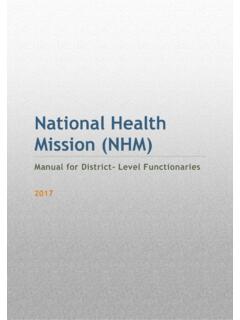Transcription of Operational productivity and performance in English NHS ...
1 Operational productivity and performance in English NHS ambulance Trusts: Unwarranted variations Foreword by Lord Carter of Coles The ambulance service plays a pivotal role in saving lives and has a major influence on the flow of patients to hospitals. Trusts answered 10 million 999 calls and responded to over seven million separate incidents last year. Nine out of 10 of these calls were not life-threatening but were lower acuity calls, often involving elderly patients, and nearly 60% of responses resulted in a patient being conveyed to A&E.
2 Over two million patients brought to A&E were admitted to wards and at any one time 40% of all patients in hospital beds in England will have been taken to hospital in an ambulance . The speed of response to stroke or cardiac arrest victims can be the difference between life and death. ambulance services are also at the forefront of responding to major incidents. The tragic events at Manchester Arena last year saw the first call to the ambulance service at , one minute after the bomb exploded. An advanced paramedic, self-deployed, arrived on scene 10 minutes later.
3 In this review I have been struck by the dedication of all those working in the ambulance service. The Five Year Forward View outlines an ambition to place care closer to home, but further work is needed to make this a reality. In my review of community health services, I identified that elderly patients, whose average length of stay in hospital for a non- elective admission is 13 days, needed a focused approach. Nowhere is this more evident than when looking at ambulances services. Being taken to hospital in an ambulance is not always in the best interests of the patient and is sometimes expressly against their wishes or their agreed care plan.
4 In this review I have identified significant unwarranted variation in the proportion of patients that ambulance services take to hospitals across England. Tackling avoidable conveyances to hospital, particularly for elderly patients, supports delivery of care closer to home, reduces unnecessary pressures on our A&Es and wards and could release capacity equivalent to 300 million in the acute sector. ambulance trusts must play their role, but action is required to ensure that alternative health services are in place and responsive to patients need.
5 Delivering effective urgent and emergency care I consider that there are three structural issues in the provision of health services which need to be strengthened to improve patient experience and reduce avoidable conveyance. 1. Ability to access general practice and community services. To reduce avoidable conveyance, ambulance staff need to be aware of and able to easily access health services in the community. Plans to roll out evening and weekend GP appointments to 50% of the public by March 2018 have been met and NHS England are on track to deliver 100% by October 2018.
6 However, providers of community services and mental health trusts consistently told us they would be able to do more to prevent admissions if the healthcare system was more joined up. 2. Urgent treatment centres. About 100 designated urgent treatment centres have been established, although this is lagging behind expectations and there are regional variations in the provision of these services. NHS England is working with local areas 1. to confirm their delivery plans, but action needs to be taken by strategic and transformation partnerships, working with ambulance services, to accelerate progress before winter.
7 3. Hospital handover delays. ambulance services are well-placed to understand the performance of the hospitals as they, along with patients, suffer from unacceptable delays at A&E. This has a significant impact on the services ability to get to other patients and cost the ambulance service nearly 50 million last winter. Operational improvement Since January 2017 we have engaged with all 10 ambulance trusts in England and talked to the teams and patients who use their services. We have analysed the productivity of ambulance trusts over time and seen that there has been significant divergence in their productivity .
8 If all trusts implement the practice of the best, the scope for greater productivity is around 200 million by 2021. These productivity benefits should be reinvested in improving patient care to support the Government's commitment to return to delivery of key performance standards. Our work has identified three important areas where Operational improvement must be made. 1. Staff. ambulance staff do hugely challenging jobs day in, day out. Giving detailed attention to ensuring they receive the right level of support is critical.
9 Levels of sickness and engagement across ambulance staff are some of the most problematic in the NHS and should be addressed culturally. Staff need greater clinical and managerial support to ensure they feel confident in treating a patient over the phone or on scene and are supported by effective rotas which match supply to patient demand. 2. The digital ambulance service. ambulance services have been at the forefront of technological innovation for many years but there needs to be renewed emphasis in this area. Auto dispatch technology was proved to shave valuable seconds from responses to patients who suffered from cardiac arrest 12 years ago but is yet to be fully implemented across all ambulance trusts in England.
10 New technology is not adopted rapidly across the service and this, plus the weakness identified in the control centre infrastructure, must be addressed. ambulance services need to plan for tomorrow's service today and develop robust plans to rapidly improve the resilience of the infrastructure. 3. Effective fleet management. It is simply unacceptable that trusts purchase different ambulances and stock them with different equipment and medicines. This demonstrably increases costs and there is an unarguable case to develop a common specification across England and move rapidly to centralised procurement for the ambulance fleet.

















